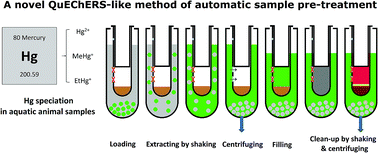A novel QuEChERS-like method and automatic sample pre-treatment apparatus for fast determination of mercury speciation in aquatic animal samples†
Abstract
The accurate, stable and fast analysis of mercury species, such as Hg2+, MetHg and EtHg, in complicated aquatic animal matrices is an ongoing challenge. Herein, an efficient analytical method for Hg species was developed using a QuEChERS-like approach (QuEChERS is a sample preparation method for pesticide residue determination based on dispersive solid phase extraction which is quick, easy, cheap, effective, rugged and safe) followed by liquid chromatograph atomic fluorescence spectrometry (LC-AFS). For the first time, a novel concentric tube extraction cell consisting of an outer tube (o-tube), an inner tube (i-tube), a cap for the o-tube and a stopper for the i-tube with a series of PVDF membranes was designed as an integrated tool for extracting and purifying Hg species, where the membrane acts as a “valve” driven by centrifugal force vs. the membrane surface tension force. Here, the newly designed QuEChERS automated sample preparation system was used for shaking and centrifugation of the test samples. Aquatic animal samples were extracted with 10% HCl + 1% thiourea + 0.15% KCl solution in the o-tube by shaking at 800 rpm for 12 min; then, under the force arising from centrifugation at 4000 rpm for 5 min, the analyte solution containing Hg species penetrated the membrane into the i-tube; after shaking at 600 rpm for 3 min and centrifuging at 4000 rpm for 2 min, 0.5 mL chloroform pre-added to the i-tube separated the proteins and lipids from Hg species; finally, the upper layer extract in the i-tube was studied by LC-AFS. Under the optimum conditions, from 5 μg L−1 to 1000 μg L−1, the linear regression coefficient (R2) was >0.998; the spiked recoveries of Hg2+, MetHg and EtHg in aquatic animal samples were in the 88% to 104% range, and the method could achieve desirable limits of detection below 3 μg kg−1 (sample mass = 2 g). The relative standard deviations (RSD) were <10% for 10 μg kg−1 standards and real samples, including fish, lobster, scallop and carp; this precision was found to be acceptable. The whole sample pre-treatment duration can be controlled within 25 min, namely an average of ∼2 min per sample considering 12-sample throughput of the automated sample preparation system. The proposed QuEChERS-like LC-AFS method is suitable for Hg2+, MetHg and EtHg determination in aquatic animal samples, with advantages of simplicity, quickness, accuracy, high sensitivity and minimum personal error, to protect public health against mercury hazards.



 Please wait while we load your content...
Please wait while we load your content...